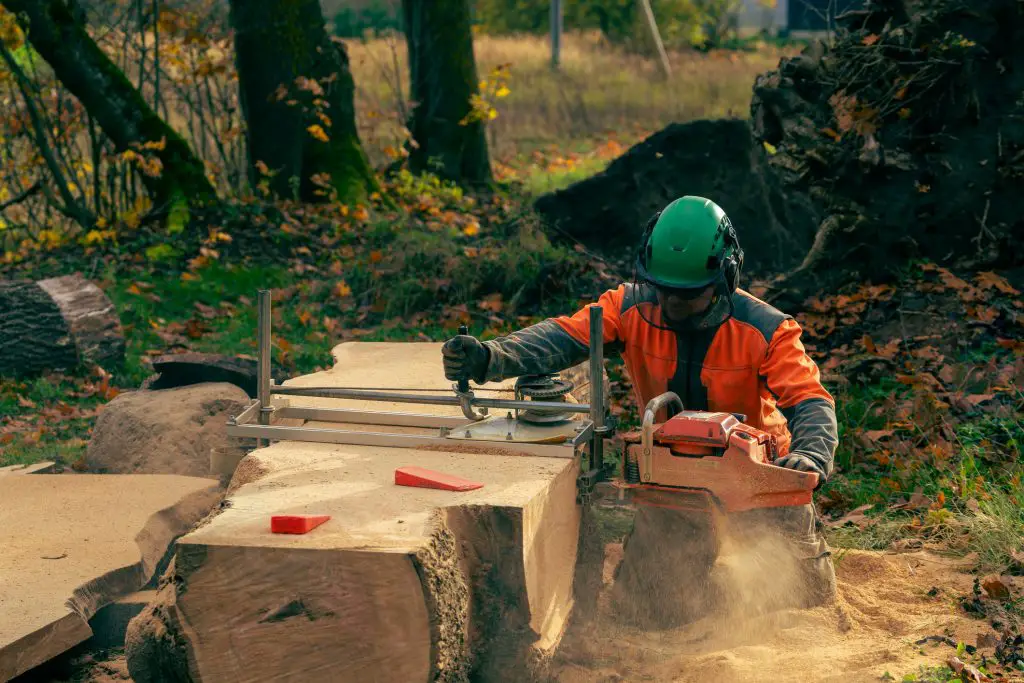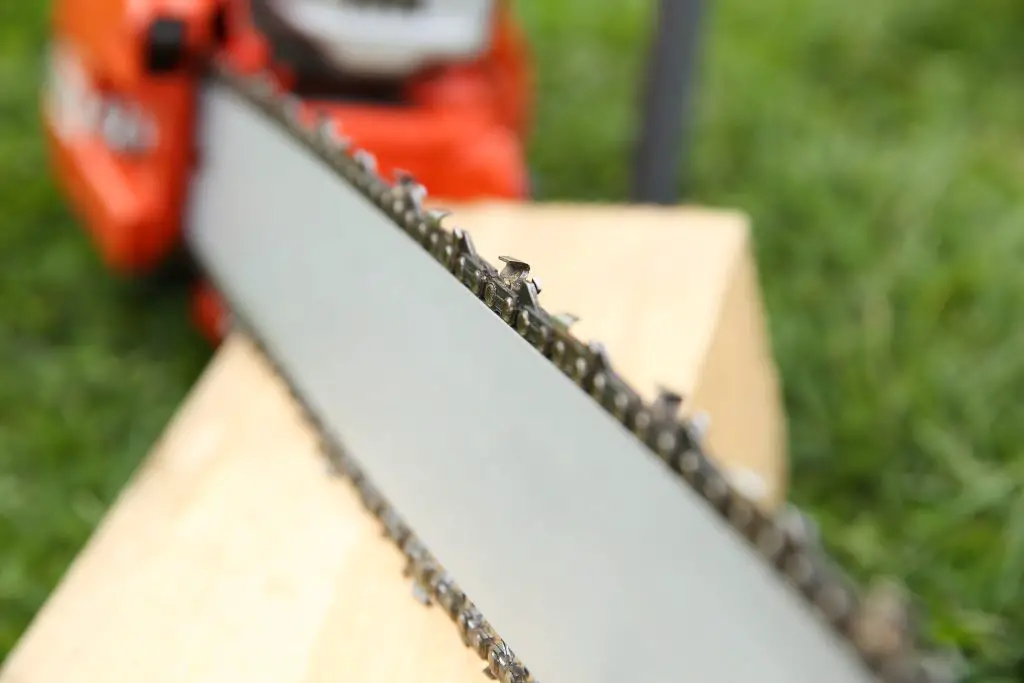This post contains affiliate links.
Milling timber with a chainsaw is different from felling trees or cutting timber into manageable sizes. Milling timber requires making long rip cuts through the timber to process logs into wood of the required length. This type of cut will put excessive strain on a chainsaw if the wrong chain is used.
The best ripping chain for milling is a chain specifically designed for making these cuts through timber. The best chain for this purpose is Ganberg rip chains with the combination of scoring and full-width teeth that make the cut cleaner, faster while minimizing wear on the chainsaw.
While milling timber with a chainsaw is possible and effective, ripping longitudinally through timber requires a chain made for the task. I have just the information you need to determine the best ripping chain for milling with your chainsaw.

Best Ripping Chain for Chainsaw Timber Milling
A rip cut through timber and a crosscut place different stresses on both the chainsaw and the chain. A crosscut cuts across the grain of the timber, making the timber shorter. A rip cut is a cut in the same direction as the wood grain, cutting the wood thinner rather than shorter.
Crosscuts are more difficult for the saw and chain, but they are of much shorter duration. Rip cuts are easier for the chain and saw but are of a much longer duration, causing more wear on the chain.
Crosscut chains are much more aggressive in their cutting action, and as a result, using a crosscut chain to make rip cuts through the timber will cause the chainsaw to work much harder for a longer duration. This will cause excessive and unnecessary wear and tear on the chainsaw motor and components such as the chain drive mechanism.
Find out if your chainsaw and bar are up to the challenge of milling wood in my articles, What Size Bar To Use on a Chainsaw Mill and What size of saw do I need for a Chainsaw mill.
What Are The Features Of A Ripping Chain?
The most visible difference in a ripping chain compared to a standard crosscut chain is the angle of the cutting teeth. Crosscut chains typically have the teeth sharpened to a fairly steep angle of between 25° and 35°. A rip chain has teeth sharpened to a 10° angle. Learn more about sharpening a chain saw in my article, What Degree Should I Sharpen my Chainsaw?
Some ripping chains have angles of 20° on the teeth, and while these chains will cut faster, they will also dull faster. Certain rip chain manufacturers have different angle grinds on the chain teeth in a specific sequence to make the cutting more efficient and reduce the wear on the chain.
While these chains work well, they are more complicated to sharpen, requiring more tools and guides to get the correct sharpening angle.
The shallow angle of the teeth makes it easier for the chain to cut both hard and softwood timber and retain cutting sharpness for longer.
This is necessary for a ripping chain since the length of the cuts are much longer, causing more wear and tear on the chain’s teeth.
A rip chain produces a much cleaner cut on the timber than a crosscut chain, requiring less work to get the cut face of the timber smooth.

Top Rip Chain Choice: Granberg Ripping Chains
Granberg International is a US company that has been involved in the chainsaw industry since 1954. Granberg is probably most notably known for their Alaskan Chainsaw Mill, which is a rig that turns a standard chainsaw into a milling chainsaw.
It was a natural development for the company to begin producing rip chainsaw chains to match their chainsaw mill product. The company’s motto of “smarter, not harder” drives them to develop products that make difficult tasks easier.
Granberg rip chains often have teeth in sets of 4, with the first two teeth in the set being narrower scoring teeth and the last two in the set being full-size clearing teeth. The scoring teeth cut a groove of each side of the cut, while the clearing teeth clear out the middle of the cut.
This cutting method places less strain on the teeth, reducing the wear on the chain and reducing the feeding pressure required to cut the timber. This tooth arrangement also makes for a cleaner, smooth cut and places less strain on the chainsaw motor.
The main problem associated with Granberg rip chains is sourcing a supplier in your region. This is mostly due to the Granberg chains being priced significantly higher than many competing chains.
A Granberg rip chain, depending on specifications, can cost between $26 to $150. While these rip chinas are of excellent quality and last a long time, the price is typically 15% more than other similar chains. However, Granberg chains cut faster and last longer than most other rip chains.
Granberg chains are available directly from the manufacturer’s website. Unfortunately, Amazon and Northern Tool do not seem to carry them but they do carry the Granberg Alaskan Mills.
Second Rip Chain Choice: Oregon Rip Chains
Oregon Tool is our second choice for a top rip chain product. This is a US company founded in 1947 in Portland, Oregon.
The founder, Joseph Cox, worked in the lumber industry but was also an inventor. After observing a timber beetle larvae chew through wood with ease, either with the grain or against the grain, he came up with an idea for chainsaw teeth.
This saw the chipper chain teeth invention that is the basis for modern chainsaw chains today. Oregon has continued to develop their designs and, as a result, are one of the leading chainsaw chain manufacturers today.
The teeth on the Oregon chains are made from 01-tool steel, which gives the chain good durability. The price on Orgon chains is good, but the chains do not cut as fast as Granberg chains and do not last as long.
They are, however, a good product and will give good service as a milling rip chain. Oregon advises that their rip chains must not be used to cut timber freehand but are only certified for use in a chainsaw mill.
Using the chainsaw freehand with one of these chains installed can result in dangerous kickback, which is an event your should try to avoid at all costs.
The price of Oregon chains is very competitive, with most entry-level chains starting at a little below $20 and increasing in price depending on the different specifications.
Both Amazon and Northern Tool carry these chains and your local chainsaw dealership will likely as well. Just double-check the size your chainsaw needs before buying.
- 72rd: 3/8-inch pitch, 050-inch gauge
- Standard chassis and cutter parts are used; cutter grind is the only difference from...
- For use on chain-type sawmills; not recommended for hand-held use
Final Thoughts
The best chainsaw blade for milling is one that has been designed specifically for making rip cuts through the timber. The design of these chains makes the cut easier, reducing wear on the chain and the chainsaw.
My top choice for the best chain for milling is the Granberg chains, with their unique tooth design that makes for a faster rip cut and a longer-lasting chain. But if I can’t get my hands on a Granberg chain, Oregon makes very good ripping chains too.


